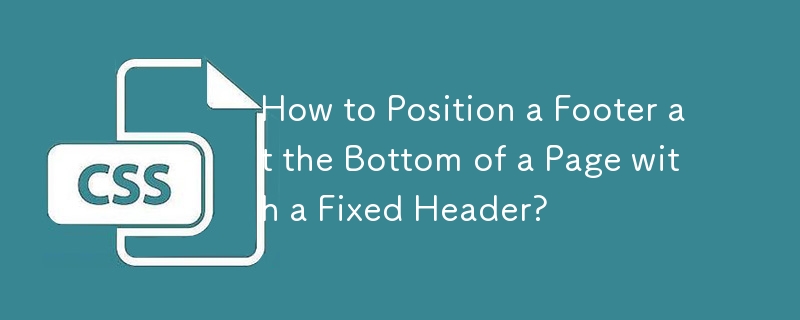 Web Front-end
Web Front-end
 CSS Tutorial
CSS Tutorial
 How to Position a Footer at the Bottom of a Page with a Fixed Header?
How to Position a Footer at the Bottom of a Page with a Fixed Header?
How to Position a Footer at the Bottom of a Page with a Fixed Header?

Positioning Footer at the Bottom of a Page with a Fixed Header
Understanding the Issue and Requirements:
You seek to position the footer at the absolute bottom of the page, even when there's a fixed header. This eliminates using position: fixed or having the footer at the bottom of the visible screen.
Ryan Fait's Sticky Footer Method:
We'll employ Ryan Fait's approach as it fulfills your specific conditions:
Steps:
- Set HTML and Body Height to 100%: Define height: 100% for and to establish a 100% viewport height.
- Give Content a 100% Minimum Height: Assign #content a min-height: 100% to ensure it takes up the entire viewport height.
- Position Footer Absolutely and Offset Content: To position the footer below #content, give #content a negative margin-bottom equal to the footer's height. Then, position #footer absolutely to place it above #content.
-
Prevent Content from Overlapping Footer: Two options:
-
Spacer Element: Add a
- Padding-Bottom and Box-Sizing: Use padding-bottom: 100px and box-sizing: border-box on #content (with proper vendor prefixes).
Adding the Header:
- Header in Normal Flow: For a header in the normal flow, nest it within #content.
- Absolutely Positioned Header: To position the header absolutely, adjust #content's padding-top accordingly.
Modern Approach with Box-Sizing:
Modern browsers fully support box-sizing: border-box, which eliminates the need for spacer elements. However, using spacer elements remains suitable for wider browser compatibility.
Conclusion:
This approach provides a robust solution for positioning the footer at the bottom of the page with a fixed header, ensuring optimal display on all devices.
The above is the detailed content of How to Position a Footer at the Bottom of a Page with a Fixed Header?. For more information, please follow other related articles on the PHP Chinese website!
-
Spacer Element: Add a

Hot AI Tools

Undresser.AI Undress
AI-powered app for creating realistic nude photos

AI Clothes Remover
Online AI tool for removing clothes from photos.

Undress AI Tool
Undress images for free

Clothoff.io
AI clothes remover

Video Face Swap
Swap faces in any video effortlessly with our completely free AI face swap tool!

Hot Article

Hot Tools

Notepad++7.3.1
Easy-to-use and free code editor

SublimeText3 Chinese version
Chinese version, very easy to use

Zend Studio 13.0.1
Powerful PHP integrated development environment

Dreamweaver CS6
Visual web development tools

SublimeText3 Mac version
God-level code editing software (SublimeText3)

Hot Topics
 Vue 3
Apr 02, 2025 pm 06:32 PM
Vue 3
Apr 02, 2025 pm 06:32 PM
It's out! Congrats to the Vue team for getting it done, I know it was a massive effort and a long time coming. All new docs, as well.
 Can you get valid CSS property values from the browser?
Apr 02, 2025 pm 06:17 PM
Can you get valid CSS property values from the browser?
Apr 02, 2025 pm 06:17 PM
I had someone write in with this very legit question. Lea just blogged about how you can get valid CSS properties themselves from the browser. That's like this.
 A bit on ci/cd
Apr 02, 2025 pm 06:21 PM
A bit on ci/cd
Apr 02, 2025 pm 06:21 PM
I'd say "website" fits better than "mobile app" but I like this framing from Max Lynch:
 Stacked Cards with Sticky Positioning and a Dash of Sass
Apr 03, 2025 am 10:30 AM
Stacked Cards with Sticky Positioning and a Dash of Sass
Apr 03, 2025 am 10:30 AM
The other day, I spotted this particularly lovely bit from Corey Ginnivan’s website where a collection of cards stack on top of one another as you scroll.
 Using Markdown and Localization in the WordPress Block Editor
Apr 02, 2025 am 04:27 AM
Using Markdown and Localization in the WordPress Block Editor
Apr 02, 2025 am 04:27 AM
If we need to show documentation to the user directly in the WordPress editor, what is the best way to do it?
 Comparing Browsers for Responsive Design
Apr 02, 2025 pm 06:25 PM
Comparing Browsers for Responsive Design
Apr 02, 2025 pm 06:25 PM
There are a number of these desktop apps where the goal is showing your site at different dimensions all at the same time. So you can, for example, be writing
 How to Use CSS Grid for Sticky Headers and Footers
Apr 02, 2025 pm 06:29 PM
How to Use CSS Grid for Sticky Headers and Footers
Apr 02, 2025 pm 06:29 PM
CSS Grid is a collection of properties designed to make layout easier than it’s ever been. Like anything, there's a bit of a learning curve, but Grid is
 Google Fonts Variable Fonts
Apr 09, 2025 am 10:42 AM
Google Fonts Variable Fonts
Apr 09, 2025 am 10:42 AM
I see Google Fonts rolled out a new design (Tweet). Compared to the last big redesign, this feels much more iterative. I can barely tell the difference





